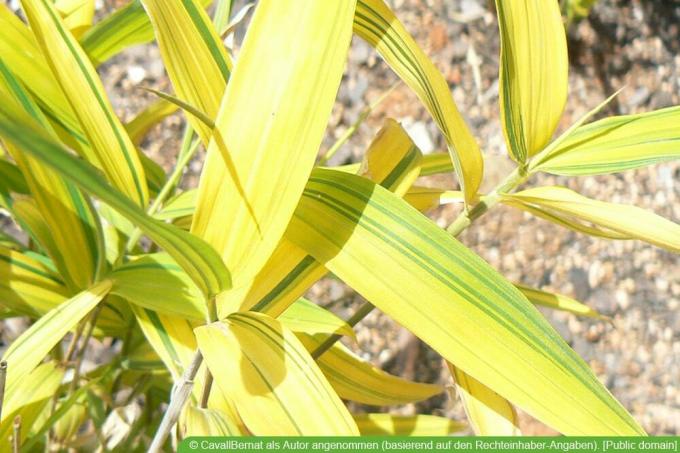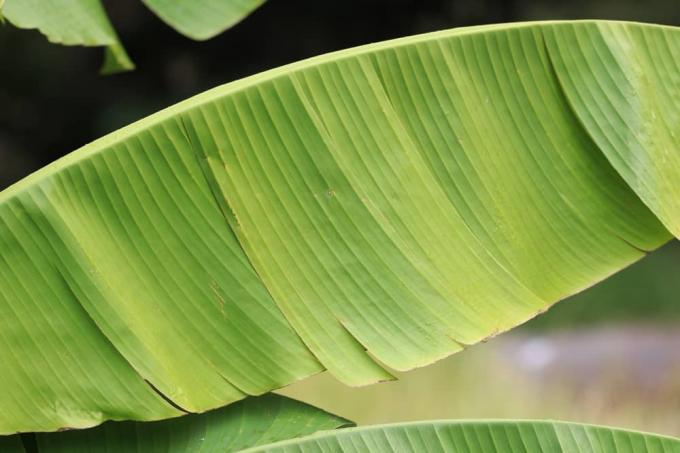

Table of contents
- General information
- sorts
- hardiness
- Tips for care
- Location
- planting distance
- Plant
- bucket
- fertilizer
- Water
- pests
- Diseases
- Cut
- Suitability of the dwarf bamboo
- propagation
Bamboo is popular with many gardeners because it makes good privacy screens and is easy to care for. This is especially true for the varieties that are several meters high. The dwarf bamboo, on the other hand, is not suitable for hedges, but the very small species can be used as a lawn substitute. It does not require any more care than other grasses and is robust and long-lasting when treated correctly.
General information
Most of the short bamboo varieties originally come from Japan. They are also often used in garden design. Mainly as a ground cover or as a lawn plant. Bamboo is durable and not susceptible to disease. It flowers only rarely, in the case of small varieties about every 12 to over 100 years. After flowering, the plants usually die, but flowering bamboo is rarely seen in the garden.
sorts
Pleioblastus fortunei
- bushy growth
- green and white striped leaves
- 40 to 80 cm high
- Location sunny to shady
Pleioblastus pumilus
- fast growing
- dark green leaves
- 40 to 80 cm high
- Location sheltered from the wind, sunny to semi-shady
Pleioblastus pygmaeus
- raging growth
- narrow leaves
- 10 to 30 cm high
- Location preferably large-scale
Pleioblastus distichus
- dense growth
- green leaves
- 40 to 60 cm high
Pleioblastus viridistriatus
- green and white striped leaves
- up to 80 cm high
- Partially shaded location
hardiness
Small bamboo, like its larger relatives, is usually hardy. Depending on the variety, it tolerates low temperatures of minus 15 to minus 20 degrees. Some varieties also survive minus 24 degrees. However, these values refer to outdoor planting. The situation is different with bamboo in pots and tubs. Because of the smaller soil volume, they only tolerate low minus temperatures. It is safer to keep potted plants frost-free in winter and give them winter protection.
Outdoors, only young plants need protection from frost. If older dwarf bamboos freeze back, this usually only affects the above-ground shoots, but not the rootstocks. The bamboo usually drives out again.
A notice:
In winter, moisture is at best dangerous, it can lead to rot. The bamboo should therefore be protected from too much snow or rain.
Tips for care
With the right care, you will get more from your dwarf bamboo. We show how it works and what the most important points are.
Location
Depending on the variety, dwarf bamboos do well in sun, partial shade, or even shade. As far as light is concerned, bamboo is usually very frugal. Moist, not waterlogged soil in a wind-protected location is important. Compacted soil should be loosened well and given drainage. Bamboo needs a good supply of nutrients. However, since the bamboo does not grow as large, it does not need to be fertilized as often. The location should be dimensioned so that the plants can spread freely without overgrowing the entire garden. If there is only little space, the plants absolutely need a rhizome barrier.
planting distance

How the bamboo is planted depends on what it is to be used for. A single plant is always enough in the bucket. The planting distance outdoors is about 50 cm. Two to three plants are suitable for quickly greening one square meter of space. The bamboo quickly tends to crowd other plants, only strong, deep-rooted plants can assert themselves against it.
Plant
The small bamboo is planted in autumn. Outdoors, the best time is from August to October. Then the dwarf bamboo can still get used to it and the rhizome begins to grow and spread. A hole is dug at the planned location, which is about the same size as the purchased dwarf bamboo pot. The substrate is loosened up, and compost can be mixed in if the soil is poor. If the substrate is dense, such as clay, drainage can help and the soil is mixed with sand to make it more permeable. Before the dwarf bamboo is used, it must be thoroughly watered. After planting, it is watered and regularly watered and kept moist during the initial period.
bucket
Dwarf bamboo can be kept well in larger pots. This eliminates the rhizome barrier and it is ensured that the plant cannot spread undesirably.
- choose a very large bucket
- fill with permeable, nutrient-rich substrate
- Use bamboo
- Press the soil down well all around
- water thoroughly
- keep moist in the near future
- water regularly later, when the substrate begins to dry out
- fertilize once a year necessary
- You don't necessarily have to cut potted bamboo
- repotting is necessary if the bucket is too small
- Choose a container that is at least twice as large
- In winter, be sure to put the buckets in or otherwise protect them from frost
fertilizer
Dwarf bamboo does not necessarily have to be fertilized in nutrient-rich soil. By spreading the roots, it gets the nutrients it needs on its own. Nevertheless, fertilization can help the bamboo grow or be indicated in poor soil. It is sufficient if compost is mixed into the soil once a year, ideally at the beginning of the growing season in spring. Special bamboo fertilizer can also be given.
Tip:
If the bamboo is used as a lawn substitute, it can also be supplied with ordinary lawn fertilizer.
Water
Like all grasses, bamboo needs enough water to grow. When dry, it should be watered regularly. Otherwise, watering as with lawns is not necessary, since the rhizomes can store enough liquid. Only in the growth phase and with potted plants should you be more generous with water.
pests
Bamboo can be infested by various lice or spider mites. This is especially true when the air is very dry or when the plants are kept in pots. The first measure should always be to increase the humidity. The bamboo plants can be hosed down with water to remove the lice. In the case of a severe infestation, a suitable remedy from the garden store will also help.

Young shoots can also be endangered by snails. On the other hand, it helps to install a snail fence around the plants next to the rhizome barrier. This also protects the rhizome from growing over the barrier.
Diseases
Since bamboo is a grass, it can also be attacked by diseases that otherwise occur on cereals. These include, for example, fungal diseases such as grain rust. This is characterized by yellow-orange spots on the leaves. Affected culms can be removed close to the ground.
Prevention against pests and diseases
- Maintain bamboo according to its requirements
- Increase humidity, especially for potted or container plants
- Do not plant bamboo too closely
- choose the right location
- Avoid waterlogging
- remove diseased shoots
- do not fertilize too much, this leads to weak shoots
Cut
Dwarf bamboo does not need to be pruned, but tolerates pruning very well. If it is a planting that is intended to replace the lawn, the bamboo can even be easily cut with the lawnmower. So that bamboo does not get any problems in winter, it is not cut in autumn. Any shoots that have frozen back are removed close to the ground in spring before new shoots emerge. Dead old shoots can also be cut back.
Suitability of the dwarf bamboo
In addition to being used as a lawn plant, small bamboo can also be used to secure embankments or to quickly green large, bare areas in the garden. It is well suited as a ground cover. Dwarf bamboo, which grows a little taller, is suitable for low hedges. Bamboos with multicolored leaves are particularly decorative.
propagation
If the bamboo is to be propagated, this is done using sections of the rhizome. They are dug up at the old location and simply replanted at the new location. Propagation by seed is more difficult and uncommon. In addition, the plants take much longer to grow big and vigorous.
 garden editorial
garden editorial I write about everything that interests me in my garden.
Learn more about potted plants

Abalie, Abelia grandiflora: 14 tips for proper care
The large-flowered abalia (Abelia grandiflora) is an extraordinarily easy-care ornamental shrub that delights with numerous funnel-shaped and subtly scented flowers. It is just as suitable as a background plant as a hedge or container plant.

Caring for the tangerine tree properly | 13 tips for the tangerine tree
Many citrus plants have evolved from the tangerine, one of the oldest and most original citrus species. With its white flowers and orange fruits, it is a feast for the eyes and the palate. In this country it is only cultivated as a container plant due to its sensitivity to frost.

Indian canna, Canna indica | 13 tips for care
Canna indica, also known by the botanical name Canna indica, is a decorative plant that not only enriches every garden during flowering. In pot culture, it can be used as an accent for many years thanks to its color and growth.

11 absolutely hardy container plants
Absolutely hardy potted plants have several advantages to offer, because they can remain outdoors even when the temperature is below zero and require little protection. If they are also evergreen, they can also bring joy all year round.

Pink dwarf banana, Musa velutina | Care of the Kenya Banana
The pink dwarf banana (Musa velutina) is an eye-catcher in the garden. It grows to a maximum of two meters and impresses with its impressive flowers. The small pink fruits taste sweet and aromatic. If you want to harvest the exotic fruits, you should follow our care tips.

Fig tree, Ficus carica: Care from A-Z | 4 tips for growth
The fig is one of the oldest cultivated plants, as its sugary fruits were used as a sweetener in the past. The fig tree comes from Asia Minor, but can also be cultivated in this country. The advantage is that the fig is easy to care for.

